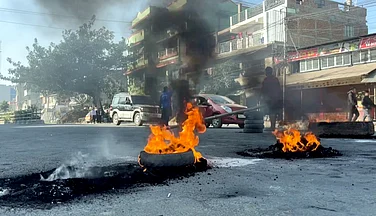This is the cover story for Outlook's September 2024 magazine issue 'Lest We Forget'. To read more stories from the issue, click here
The Kunan Poshpora alleged mass rape case remains unresolved, and with time seemingly frozen for the villagers in the remote Kupwara region of Kashmir Valley. The residents are reluctant to discuss the case, and their lawyer prefers to avoid addressing it in Kashmir’s current climate. Although the case has been before two Jammu and Kashmir courts and the Supreme Court.
The case surfaced briefly in March 2022, when the Commander of Srinagar-based 15 Corps Lt Gen D P Pandey, during a visit to Kunan village said, the women, who claimed to have been raped, had suffered immensely because of the people involved in that “nexus”. “Some women were used by a 'nexus' to create a 'fake narrative' of mass rape by the Army personnel in Kunan-Poshpora villages of Kupwara district in Kashmir in 1991,” he said. Lt Gen Pandey said that in 2021, a delegation from Kunan-Poshpora had met him and narrated how a “nexus” had used some women in the twin-villages to cook up a story of mass rape on February 23, 1991.
Allegedly, on the night of February 23/24, 1991, a Battalion of the Fourth Rajputana Rifles of the 68th Brigade conducted a cordon-and-search operation in the Kunan-Poshpora villages. The villagers alleged that while the army interrogated the men, they gang-raped the women in their homes.
On March 5, 1991, after reports of the alleged mass rape drew international and national media attention, the then-Deputy Commissioner S M Yaseen Andrabi recorded the villagers’ statements. Subsequently, he sent the report to the then-Divisional Commissioner Kashmir Wajahat Habibullah seeking inquiry as the issue would have an “adverse” impact on governance. On March 8, 1991 a first information report under sections 376, 452 and 342 of the Ranbir Penal Code at the Police Station Trehgam.
The Army had conducted its own inquiry with the Brigadier level officer visiting the village on March 10 1991. The inquiry report concluded that “the charges (of rape) are… unfounded and mischievous” and levelled to “defame the army.”
On March 18 1991 the then-Divisional Commissioner Wajahat Habibullah visited the village. Habibullah’s leaked report claimed that it was impossible “to believe that officers of such force as the Indian army would lead their men into the village with sole aim of violating the women.” The government then deputed a Press Council of India team led by B G Verghese to investigate the allegations.
Verghese visited the villages on June 8 and 9, 1991. His team dismissed the allegations and called the incident a “massive hoax” orchestrated by militant groups. However, human rights groups revealed that a police report recorded that their investigation showed that the rapes were prima facie proved.
On March 22, 1991, the DGP conducted another investigation. A human rights report says that the team examined 33 women on March 15 and March 21, 1991. It confirmed the rape allegations. The medical report says that the women’s bodies showed “resolving laceration on the vaginal walls and marks of violence , contusions, and multiple abrasions.” The human rights groups say all women examined by the medical team had said the army officers raped them multiple times.
On September 23 1991, however, the Director Prosecution informed the Superintendent of Police Kupwara that the case was unfit for prosecution. The police closed the case as untraced.
The case surfaced again in 2004. According to a 2004 report of Jammu and Kashmir Coalition of Civil Society (JKCS), one of the survivors, along with another person, approached the State Human Rights Commission (SHRC) for proper investigation. The SHRC sought a report from the DGP. In 2010, the police, according to the JKCS report, upheld the survivors’ medical reports but stated that the case was closed since there had been no identification parade of the army personnel. The SHRC later observed that 40 women were raped while not a single “anti-national element was apprehended on that night.” The SHRC recommended reinvestigating the case through a time-bound Special Investigation Team (SIT) headed by an SSP rank officer or above, and Rs two lakhs compensation per victim.
In 2013 after Nirbhaya rape case, many women from the village filed a PIL before the J&K High Court. At the same time J&K police filed a closure report before the sub-judge Kupwara. However, the sub-judge ordered further investigation. The High Court stayed the order in 2015 after the Army objected. The government, in 2014, challenged the SHRC order of victims’ compensation before the SC. While the SHRC order says that the “DGP tried push the collective crime committed by the army personnel under carpet” medical examination point towards “gang rape.” The SHRC was removed after abrogation of Article 370, and the case remains unheard by the HC, at sub-judge in Kupwara or in Supreme Court.
(A shorter, edited version of this appeared in the print as 'Kunan Poshpora: Frozen in Time')

















